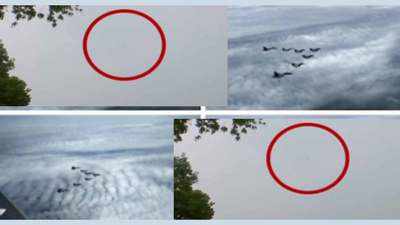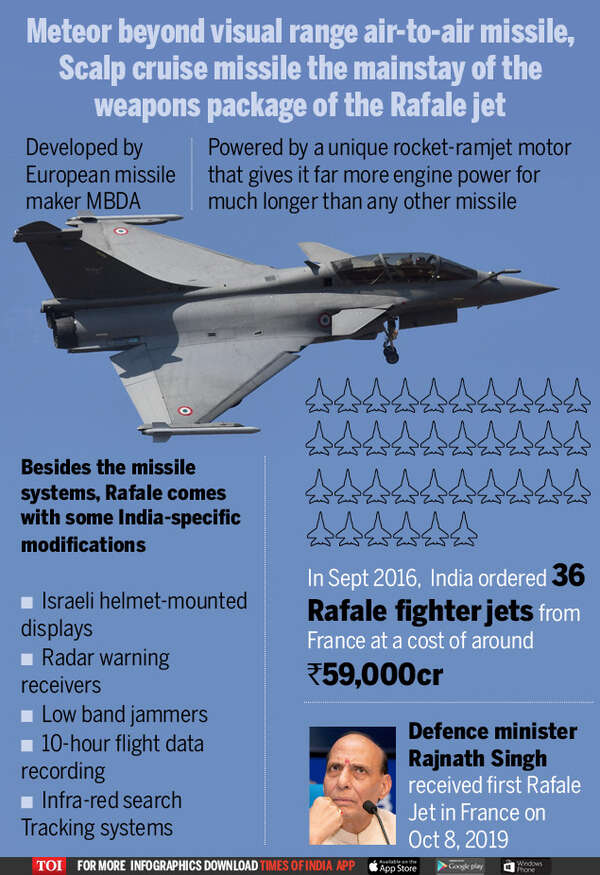- News
- India News
- Rafales land in Ambala: How 'game-changer' jets will boost India's air power
Trending
This story is from July 29, 2020
Rafales land in Ambala: How 'game-changer' jets will boost India's air power
India's first five Rafale fighters - 3 single-seat & 2 twin-seat - finally tore into its skies on Wednesday after a 7,000-km flight from France which included an overnight pit stop in UAE and mid-air refuelling. Dubbed as "game-changers" by the Indian Air Force, the Rafales will be able to outgun and outrun Pakistani F-16 and JF-17 as well as the Chinese Chengdu J-20 fighters.

NEW DELHI: India's first five Rafale fighters - 3 single-seat & 2 twin-seat - finally tore into its skies on Wednesday after a 7,000-km flight from France which included an overnight pit stop in UAE and midair refueling.
Dubbed as "game-changers" by the Indian Air Force, the fighters have touched down in Ambala in the middle of the ongoing military confrontation with China which could stretch to the winter, or even beyond.
Welcoming the jets in India, defence minister Rajnath Singh said that the touch down of Rafale aircraft marks the beginning of a new era in our military history.
While the jets will take time to be properly integrated into the war-fighting machinery, they will certainly be a force to reckon with when they are fully operational.
Once ready, the Rafales will be able to outgun and outrun Pakistani F-16 and JF-17 as well as the Chinese Chengdu J-20 fighters.


In fact, sources have said the air-to-air and the air-to-ground strike capabilities of Rafales cannot be matched by either China or Pakistan and the aircraft would give India an edge over both the rivals
With a combat range of 780-km to 1,650-km depending on mission, the jets come armed with a deadly weapons package, advanced avionics, radars and electronic warfare systems to prevent jamming by adversaries and ensure superior survivability in hostile contested airspace.
Each Rafale can carry two fire-and-forget Scalp cruise missiles to hit high-value fortified targets well over 300-km away.
The Rafales are also armed with 'Meteor’ air-to-air missiles which have 120-150 km strike range. The Meteor missiles are arguably the best in the world for air combat duels, with “a greater no-escape zone” for hostile fighters than any comparable BVR weapon. Pakistan and China do not currently have any missiles of this class in their combat inventories.
The jets will also have 13 India-Specific Enhancements (ISEs) or upgrades which will become fully operational in 2022 after undergoing “software certification”.
The upgrades range from radar enhancements, Israeli helmet-mounted displays and low-band jammers to towed decoy systems, 10-hour flight data recording and engine capability for "cold start" from high-altitude regions like Ladakh.
India is also planning to equip its new Rafale jets with the “Hammer” air-to-ground precision-guided munitions to gain advantage over China along the LAC.
The 20- to 70-km range Hammers are designed to destroy bunkers, hardened shelters and other targets in all terrains including the mountainous ones in eastern Ladakh. A Rafale can carry up to six Hammers to hit as many targets simultaneously.
Prime Minister Narendra Modi and former IAF chief B S Dhanoa had both said that the outcome of the dogfight with Pakistan last year would have been different had Wing Commander Abhinandan Varthaman, who was captured and later released by the neighbouring country, been flying a Rafale.
Dubbed as "game-changers" by the Indian Air Force, the fighters have touched down in Ambala in the middle of the ongoing military confrontation with China which could stretch to the winter, or even beyond.
Welcoming the jets in India, defence minister Rajnath Singh said that the touch down of Rafale aircraft marks the beginning of a new era in our military history.
"This aircraft has very good flying performance and its weapons, radar and other sensors and Electronic Warfare capabilities are amongst the best in the world. Its arrival in India will make the IAF much stronger to deter any threat that may be posed on our country," Singh tweeted.
While the jets will take time to be properly integrated into the war-fighting machinery, they will certainly be a force to reckon with when they are fully operational.
Once ready, the Rafales will be able to outgun and outrun Pakistani F-16 and JF-17 as well as the Chinese Chengdu J-20 fighters.


In fact, sources have said the air-to-air and the air-to-ground strike capabilities of Rafales cannot be matched by either China or Pakistan and the aircraft would give India an edge over both the rivals
With a combat range of 780-km to 1,650-km depending on mission, the jets come armed with a deadly weapons package, advanced avionics, radars and electronic warfare systems to prevent jamming by adversaries and ensure superior survivability in hostile contested airspace.
Each Rafale can carry two fire-and-forget Scalp cruise missiles to hit high-value fortified targets well over 300-km away.
The Rafales are also armed with 'Meteor’ air-to-air missiles which have 120-150 km strike range. The Meteor missiles are arguably the best in the world for air combat duels, with “a greater no-escape zone” for hostile fighters than any comparable BVR weapon. Pakistan and China do not currently have any missiles of this class in their combat inventories.
The jets will also have 13 India-Specific Enhancements (ISEs) or upgrades which will become fully operational in 2022 after undergoing “software certification”.
The upgrades range from radar enhancements, Israeli helmet-mounted displays and low-band jammers to towed decoy systems, 10-hour flight data recording and engine capability for "cold start" from high-altitude regions like Ladakh.
India is also planning to equip its new Rafale jets with the “Hammer” air-to-ground precision-guided munitions to gain advantage over China along the LAC.
The 20- to 70-km range Hammers are designed to destroy bunkers, hardened shelters and other targets in all terrains including the mountainous ones in eastern Ladakh. A Rafale can carry up to six Hammers to hit as many targets simultaneously.
Prime Minister Narendra Modi and former IAF chief B S Dhanoa had both said that the outcome of the dogfight with Pakistan last year would have been different had Wing Commander Abhinandan Varthaman, who was captured and later released by the neighbouring country, been flying a Rafale.
End of Article
FOLLOW US ON SOCIAL MEDIA










